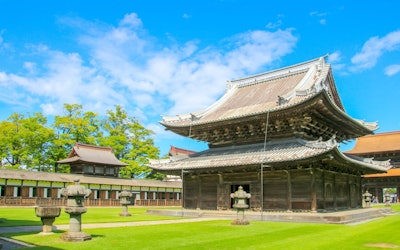Zuiryuji Temple - A National Treasure and Popular Tourist Destination in Takaoka, Toyama. Built From the Wealth of the Kaga Domain, This Amazing Example of Japanese Architecture Is Bursting With History!
Art & Architecture
Zuiryuji Temple - An Exciting Tourist Destination in Takaoka
This video, titled "JG☆☆☆☆8K HDR Toyama Zuiryuji Temple (National Treasure) - A Reflection of the Wealth and Advanced Architectural Techniques of the Kaga Domain - Enhanced Hi Technology" (JG☆☆☆☆8K HDR 富山 瑞龍寺(国宝) 加賀藩の栄華を反映した高度な建築技術 Toyama,Zuiryuji(National Treasure) Enhanced Hi Technology), was created by "JAPAN GEOGRAPHIC."
Since the opening of the Hokuriku Shinkansen line, it has become much easier to travel to Toyama prefecture from Tokyo.
In this article we'll go over a sightseeing spot we recommend those visiting Toyama prefecture check out!
Without further ado, let's take a look at "Zuiryuji Temple."
Zuiryuji Temple is a popular sightseeing destination in the city of Takaoka, Toyama Prefecture (previously known as the Kaga Domain), that has been designated a national treasure.
The buildings, hallways and gardens are so beautifully crafted calling them works of art wouldn't be inaccurate.
We hope you enjoy watching this video and experiencing what it feels like to walk the grounds of Zuiryuji Temple.
The History of Zuiryuji Temple
Photo:Sanmon gate at Zuiryuji Temple, Toyama Prefecture
Zuiryuji Temple was built during the Kamakura period (1185 AD - 1333 AD) by the second generation Kaga domain feudal lord Toshinaga Maeda (前田利長).
The temple was later named "Zuiryuin" (瑞龍院) by the third generation Kaga domain feudal lord Toshitsune Maeda (前田利常).
The three main buildings of the temple: Sanmon Gate (山門), Butsuden (仏殿) and Hodo (法堂)), are built in a straight line (each one behind the other) in a beautiful symmetrical design.
The current Sanmon Gate, seen at 0:28 in the video, was once destroyed by fire and rebuilt in the Edo period (1603 AD - 1868 AD).
Major repairs were made during the Showa (昭和) and Heisei periods (平成) and Zuiryuji temple was officially registered as a national treasure in 1997.
The burial ground of Toshinaga Maeda is also located within the temple grounds.
Zuiryuji Temple - An Important Cultural Property of Japan
Photo:The main gate of Zuiryuji Temple, Toyama Prefecture
Zuiryuji Temple is home to many historical objects of great value, such as the statue of the Gautama Buddha (釈迦如来) in the temple's main hall.
Seven of the temple's buildings have been designated Important Cultural Assets, including Somon Gate (総門), Zendo Hall (禅堂), Osado Hall (大茶堂), Takaroka (高廊下), the northern cloister (北回廊), the southeastern cloister (南東回廊) and the southwestern cloister (南西回廊).
The wooden statue of Vidyaraja (the wisdom king in Buddhism) is registered as a Tangible Cultural Property of Japan.
During the Edo period, the statue was placed in the bathroom and was said to have the power to bring cleanliness to dirty areas.
From 1:12 in the video, you can see the beautiful garden leading towards the main temple building, truly one of the highlights of the video.
Summary of Zuiryuji Temple
Photo:The main hall at Zuiryu-ji Temple, Toyama Prefecture
Zuiryuji Temple is one of the top sightseeing spots in the area and a great place to learn more about the history of the Kaga domain.
There is a large car park situated nearby with 100 parking spaces making it easily accessible for those traveling by car.
At Zuiryuji Temple, you can also purchase copies of sutras as well as take part in a Zazen (zen meditation) experience.
There are many hotels and Japanese ryokan situated near the closest station (JR Takaoka station (JR高岡駅)), so consider spending the night and taking your time traveling around the Hokuriku (北陸) region of Japan.
We hope that the next time you're in Japan's Hokuriku region, you'll consider visiting Zuiryuji Temple.
The trip is sure to bring peace to both your mind and soul!
【Tripadvisor】Zuiryuji Temple
https://www.tripadvisor.com/Attraction_Review-g311426-d1308244-Reviews-Zuiryuji_Temple-Takaoka_Toyama_Prefecture_Hokuriku_Chubu.html
【Official Website】National Treasure – Zuiryuji Temple – Sightseeing Spot – Tourist Information in Toyama
https://foreign.info-toyama.com/en/
 Video article 10:23
Video article 10:23 Video article 5:57
Video article 5:57